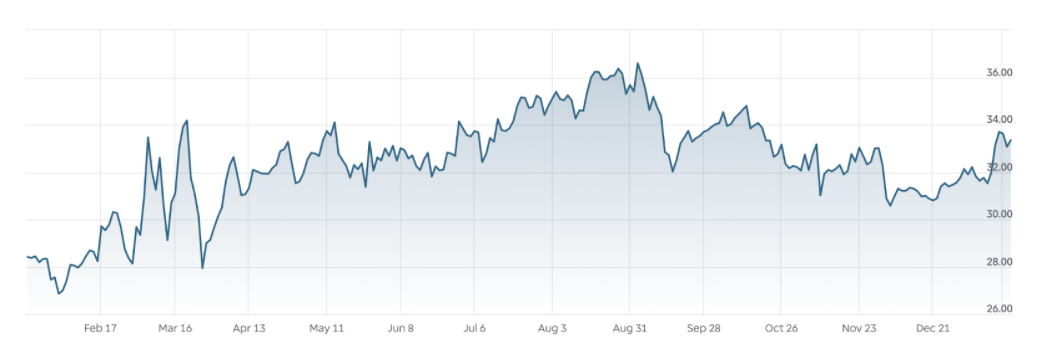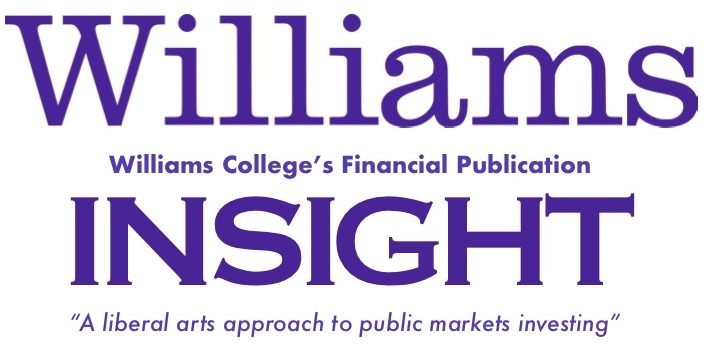By Nico Cavalluzzi
Overview
Kroger’s successful physical stores and ventures into online shopping present a twofold profit mechanism that have not only helped it succeed during COVID, but have expanded and innovated on its revenue streams for the future. Though Kroger continues to face tough competition from both big-box competitors and gourmet grocers, as well as questionable growth in the hypercompetitive delivery space, it mitigates these risks with infrastructure developments and key acquisitions that its competitors are not doing. Assuming a P/E multiple of 15x and an EPS of $3.00, conservative increases from current values of 12x and $2.75, respectively, investors can expect a share price target for Kroger of $45, a 40% premium.
Company Description
The Kroger Group (KR), founded in 1883, is a Cincinnati, Ohio based retail company. KR operates supermarkets, pharmacies, jewelry stores, petroleum stations, and multi-level department stores through one of its many subsidiaries throughout 35 US states and the District of Columbia. KR has over 400,000 employees and over 2,700 individual stores, making it one of the largest employers in America.
Company and Industry
KR is the United States’ largest supermarket by revenue, with $121.16 billion of revenue for fiscal year 2019, and the second-largest general retailer in the country, only behind Walmart (NYSE: WMT). KR, like Walmart and many of its other peer competitors, offers customer loyalty programs, online ordering and contactless delivery of its grocery and retail products.
The grocery space today is generally occupied by three types of retailers: gourmet groceries, local supermarkets, and big-box hypermarkets. KR, for instance, mainly operates in the big-box space, but also owns various regional supermarkets and groceries. Throughout the United States, grocery sales in general have been up 29.3% since March 2019, largely due to COVID-19 pandemic restrictions on restaurant operations and quarantine mandates, limiting consumer’s food options.
- Company Comparables as of January, 2021
| Company | EV | EV/EBITDA | EPS | P/E |
| Walmart (WMT) | 456B | 11.4x | $5.68 | 21.0x |
| Costco (COST) | 156B | 18.5x | $10.24 | 37.1x |
| Dollar Tree (DLTR) | 34B | 7.3x | $6.07 | 26.6x |
| Sprouts (SFM) | 4B | 5.4x | $1.82 | 9.9x |
| Kroger (KR) | 44B | 5.8x | $2.75 | 12x |
Source: Koyfin, Public Filings
Investment Catalysts
KR’s low EV/EBITDA and P/E multiples compared to industry competitors, indicating a cheaper valuation, yet consistently even performance with competitors in terms of store growth and online presence indicate that KR has the legs and space for growth until its multiples better align with competitors. Interestingly, despite a recent flurry of acquisitions and partnership, analysts have not yet priced this into KR, mainly due to uncertainties from the COVID pandemic. That said, these acquisitions pose KR well for competition in the retail space, which is increasingly becoming automated/online. First, KR made news when it acquired ClusterTruck, one of the first ghost kitchens. Ghost kitchens deliver meals to customer’s doorstep without the physical footprint of a restaurant. ClusterTruck has locations throughout the midwest, further building into KR’s dominance in the region. Additionally, KR entered into an exclusive partnership with Orcado, which focuses on direct to consumer delivery of groceries and household goods
In addition, KR analysts have raised expectations for sales and profits forecasts for 2021, largely fueled by increased home-cooking during COVID-19 extending throughout the coming year. Earnings are also forecasted to rise as online infrastructure and supply chain near completion. Increasing ventures into retail space, which require low capital expenditure, open new revenue streams, even considering competitors occupying the space currently. Assuming that KR’s acquisitions go smoothly, and they are indeed able to improve in quality, we can assume a conservative growth in profits and valuation.
- KR – 1 Year

- KR – 3 Year

As of January 21, 2021, provided by the TD Ameritrade
Key Highlights
When looking at Chart II, it seems that the largest impact of COVID-19 (typical consensus is mid-March 2020) caused a significant drop in KR stock price. However, using some further analysis we can see from Chart III that while a pullback was noticeable, KR both recovered quickly and continued growing beyond its previous 3 Year high. KR was smart in navigating the pandemic. Its ability to bounce back and take advantage of increased at home cooking can be seen in its ability to lessen the impact of economic uncertainties in the market. Returning our attention to Chart II, we can see a dip beginning in September 2020 after a strong run to $36. This dip can be accounted for by announcements of vaccines and a general loosening of restrictions in many states, especially midwestern states where KR operates and which had looser restrictions throughout the pandemic anyways.
Though it may seem that we are too late and will miss out on any COVID-related upside, recent discussions of a “second wave” and the Biden administration’s likely strong stance on enforcing quarantines means that restaurant operations will be limited for a least the next few quarters, again which can be seen by KR’s rise end of Q4 2020. Stepping back, this insight is also important because it speaks to a potential stickiness of KR in society post-COVID. While people may eventually go out 1-2 times more a week than during quarantine, where they weren’t going out at all, their positive experiences at KR stores and online means that the consumer base will either stay at pre-COVID levels or increase. As can be seen in Chart III, KR was rising Q4 2019, which we can extrapolate to a post-COVID society in 2021.
Risks
As mentioned previously, KR’s biggest short-term risk is a restaurant recapture of lost market-share and KR’s investments lacking a targetable market. With restaurants returning, it feels that trips to the grocery are slowing down. Has KR lost its momentum just when it needs it most? After all, KR lacks a strong differentiator from either its big-box competitors or local and regional high-end stores. From one end, KR is squeezed by restaurants and delivery apps like DoorDash. Consumers feel less inclined to run the supermarket for a meal they need to cook, and more inclined to press a button on their phone for already prepared food. From the other end, KR doesn’t have the global reach like a Walmart, nor the cultural influence like a Whole Foods.
Second, and possibly even more concerning, is that even if KR has market access and a differentiated product, it still has a long way to go before it fully develops the delivery infrastructure for both its online shopping and direct to consumer services. Against established online competitors like Walmart and Amazon Fresh, and even some meal kit services like BlueApron and HelloFresh, time may be the one thing KR can’t afford to waste.
Importantly, KR is trying to mitigate these risks in both the short and long term. First, KR is partnering heavily with Google’s Cloud AI software, which it hopes to use to improve the search functionality on its website for consumers looking to order groceries and consumables online. Additionally, KR’s recent investment in Mirakl, an e-marketplace for B2B and B2C retail, seems to be a keystone in its plan to rapidly bring its ambitious delivery goals to scale.
Conclusion
KR presents an interesting play for investors looking for blue-chip stocks that not only have traditionally strong dividends and stability, but are actively seeking new avenues of growth and acquiring innovative companies to achieve their goals despite instabilities and competition in the market. It does this in two ways. First, KR is setting itself up well for a competitive post-COVID 19 economy, where retail especially will most likely be geared toward online and contactless delivery and pickup. Undoubtedly, the distribution of a vaccine will lead to celebration from consumers, many of which will be eager to leave their homes and spend more time than usual going out to shop. In this scenario, KR is positioned to take advantage of its traditionally strong store presence. That said, many consumers will continue to be wary to shop in highly concentrated areas, and will continue to choose delivery. Even more so, consumers may find the speed of delivery and pickup to outweigh the experience of shopping in person, and will choose them out of convenience rather than fear. In these scenarios, KR’s investments in ClusterTruck and Orcado help KR compete with both restaurants and online groceries. These investments als allow KR to test recipes, food preparation and advertising methods, crucial consumer data it can then apply to its physical stores.
Second, KR has anchored its place at or near the top of the retail industry for the future not due to a shift in corporate values, but thanks to its flurry of acquisitions and partnerships with software and technology companies. Partnerships with Google Cloud AI and Mirakl, for example, will enable KR to quickly and effectively compete with established players in the online retail space. Overall, investors should expect steady or modest returns through the rest of 2021, with the potential for exponential growth once KR finishes developing its infrastructure of modern delivery services. Assuming a P/E multiple of 15x and an EPS of $3.00, conservative increases from 12x and $2.75, respectively, expect a share price target of $45.
KR is trading at $33.21 (+0.42%) as of close Thursday, January 21, 2020
Presented by Nico Cavalluzzi for Williams Insight
Sources
https://finance.yahoo.com/news/kroger-upgrades-2020-sales-profit-141101063.html
https://robinhood.com/stocks/KR
https://www.fool.com/investing/2020/09/17/kroger/
https://www.nasdaq.com/articles/why-is-kroger-kr-down-0.8-since-last-earnings-report-2020-10-11
https://www.investing.com/equities/kroger-co-ratios
https://finance.yahoo.com/quote/kr/key-statistics/
https://www.macrotrends.net/stocks
https://www.supermarketnews.com/online-retail/kroger-launch-digital-marketplace-fall
https://www.valueinvestorsclub.com/idea/KROGER_CO/0137861977
